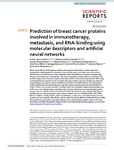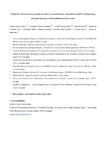Mostrar el registro sencillo del ítem
Prediction of Breast Cancer Proteins Involved in Immunotherapy, Metastasis, and RNA-Binding Using Molecular Descriptors and Artifcial Neural Networks
| dc.contributor.author | López-Cortés, Andrés | |
| dc.contributor.author | Cabrera-Andrade, Alejandro | |
| dc.contributor.author | Vázquez-Naya, José | |
| dc.contributor.author | Pazos, A. | |
| dc.contributor.author | Gonzáles-Díaz, Humberto | |
| dc.contributor.author | Paz-y-Miño, César | |
| dc.contributor.author | Guerrero, Santiago | |
| dc.contributor.author | Pérez-Castillo, Yunierkis | |
| dc.contributor.author | Tejera, Eduardo | |
| dc.contributor.author | Munteanu, Cristian-Robert | |
| dc.date.accessioned | 2020-06-03T10:02:50Z | |
| dc.date.available | 2020-06-03T10:02:50Z | |
| dc.date.issued | 2020-05-22 | |
| dc.identifier.citation | López-Cortés A, Cabrera-Andrade A, Vázquez-Naya JM, et al. Prediction of breast cancer proteins involved in immunotherapy, metastasis, and RNA-binding using molecular descriptors and artificial neural networks. Sci Rep. 2020; 10:8515 | es_ES |
| dc.identifier.issn | 2045-2322 | |
| dc.identifier.uri | http://hdl.handle.net/2183/25680 | |
| dc.description.abstract | [Abstract] Breast cancer (BC) is a heterogeneous disease where genomic alterations, protein expression deregulation, signaling pathway alterations, hormone disruption, ethnicity and environmental determinants are involved. Due to the complexity of BC, the prediction of proteins involved in this disease is a trending topic in drug design. This work is proposing accurate prediction classifer for BC proteins using six sets of protein sequence descriptors and 13 machine-learning methods. After using a univariate feature selection for the mix of fve descriptor families, the best classifer was obtained using multilayer perceptron method (artifcial neural network) and 300 features. The performance of the model is demonstrated by the area under the receiver operating characteristics (AUROC) of 0.980±0.0037, and accuracy of 0.936±0.0056 (3-fold cross-validation). Regarding the prediction of 4,504 cancer-associated proteins using this model, the best ranked cancer immunotherapy proteins related to BC were RPS27, SUPT4H1, CLPSL2, POLR2K, RPL38, AKT3, CDK3, RPS20, RASL11A and UBTD1; the best ranked metastasis driver proteins related to BC were S100A9, DDA1, TXN, PRNP, RPS27, S100A14, S100A7, MAPK1, AGR3 and NDUFA13; and the best ranked RNA-binding proteins related to BC were S100A9, TXN, RPS27L, RPS27, RPS27A, RPL38, MRPL54, PPAN, RPS20 and CSRP1. This powerful model predicts several BC-related proteins that should be deeply studied to fnd new biomarkers and better therapeutic targets. Scripts can be downloaded at https://github.com/muntisa/ neural-networks-for-breast-cancer-proteins. | es_ES |
| dc.description.sponsorship | This work was supported by a) Universidad UTE (Ecuador), b) the Collaborative Project in Genomic Data Integration (CICLOGEN) PI17/01826 funded by the Carlos III Health Institute from the Spanish National plan for Scientific and Technical Research and Innovation 2013-2016 and the European Regional Development Funds (FEDER) - “A way to build Europe”; c) the General Directorate of Culture, Education and University Management of Xunta de Galicia ED431D 2017/16 and “Drug Discovery Galician Network” Ref. ED431G/01 and the “Galician Network for Colorectal Cancer Research” (Ref. ED431D 2017/23); d) the Spanish Ministry of Economy and Competitiveness for its support through the funding of the unique installation BIOCAI (UNLC08-1E-002, UNLC13-13-3503) and the European Regional Development Funds (FEDER) by the European Union; e) the Consolidation and Structuring of Competitive Research Units - Competitive Reference Groups (ED431C 2018/49), funded by the Ministry of Education, University and Vocational Training of the Xunta de Galicia endowed with EU FEDER funds; f) research grants from Ministry of Economy and Competitiveness, MINECO, Spain (FEDER CTQ2016-74881-P), Basque government (IT1045-16), and kind support of Ikerbasque, Basque Foundation for Science; and, g) Sociedad Latinoamericana de Farmacogenómica y Medicina Personalizada (SOLFAGEM) | es_ES |
| dc.description.sponsorship | Xunta de Galicia; ED431D 2017/16 | es_ES |
| dc.description.sponsorship | Xunta de Galicia; ED431G/01 | es_ES |
| dc.description.sponsorship | Xunta de Galicia; ED431D 2017/23 | es_ES |
| dc.description.sponsorship | Xunta de Galicia; ED431C 2018/49 | es_ES |
| dc.description.sponsorship | Gobierno Vasco; IT1045-16 | es_ES |
| dc.language.iso | eng | es_ES |
| dc.publisher | Springer Nature | es_ES |
| dc.relation | info:eu-repo/grantAgreement/ISCIII/Plan Estatal de Investigación Científica y Técnica y de Innovación 2013–2016/PI17%2F01826/ES/PROYECTO COLABORATIVO DE INTEGRACION DE DATOS GENOMICOS (CICLOGEN). TECNICAS DE DATA MINING Y DOCKING MOLECULAR PARA ANALISIS DE DATOS INTEGRATIVOS EN CANCER DE COLON/ | |
| dc.relation | info:eu-repo/grantAgreement/MEC/Plan Nacional de I+D+i 2008-2011/UNLC08-1E-002/ES/Infraestructura computacional para la Red Gallega de Bioinformática | |
| dc.relation | info:eu-repo/grantAgreement/MINECO/Plan Estatal de Investigación Científica y Técnica y de Innovación 2013-2016/UNLC13-1E-2503/ES/Plataforma HPC-PLUS para aplicaciones biomédicas | |
| dc.relation | info:eu-repo/grantAgreement/AEI/Plan Estatal de Investigación Científica y Técnica y de Innovación 2013-2016/CTQ2016-74881-P/ES/REACCIONES DE ACTIVACION C-H CATALIZADAS POR METALES DE TRANSICION EN SINTESIS Y FUNCIONALIZACION DE HETEROCICLOS. NUEVAS APLICACIONES SINTETICAS Y MODELOS COMPUTACIONALES | |
| dc.relation.uri | https://doi.org/10.1038/s41598-020-65584-y | es_ES |
| dc.rights | Atribución 4.0 Internacional | es_ES |
| dc.rights.uri | http://creativecommons.org/licenses/by/4.0/ | * |
| dc.title | Prediction of Breast Cancer Proteins Involved in Immunotherapy, Metastasis, and RNA-Binding Using Molecular Descriptors and Artifcial Neural Networks | es_ES |
| dc.type | info:eu-repo/semantics/article | es_ES |
| dc.rights.access | info:eu-repo/semantics/openAccess | es_ES |
| UDC.journalTitle | Scientific Reports | es_ES |
| UDC.issue | 10 | es_ES |
| UDC.startPage | 8515 | es_ES |
Ficheros en el ítem
Este ítem aparece en la(s) siguiente(s) colección(ones)
-
GI-RNASA - Artigos [193]
-
INIBIC-RNASA-IMEDIR - Artigos [46]







